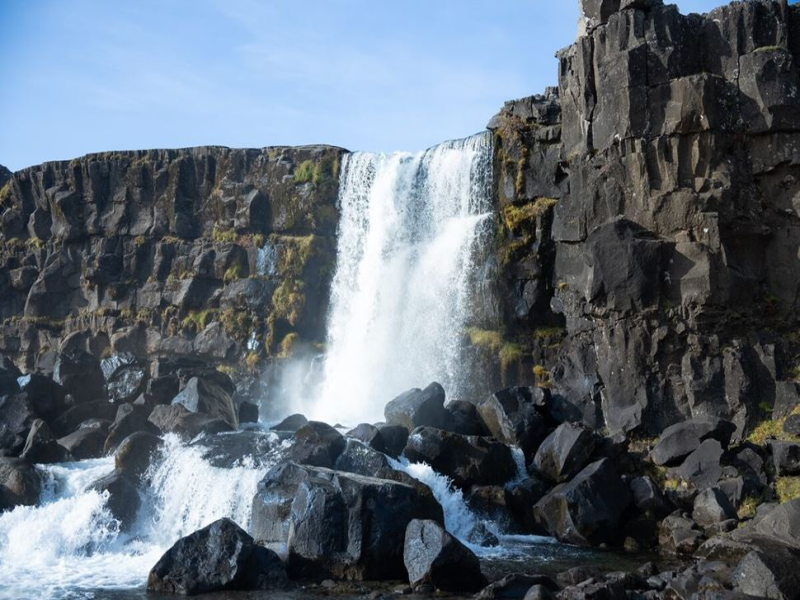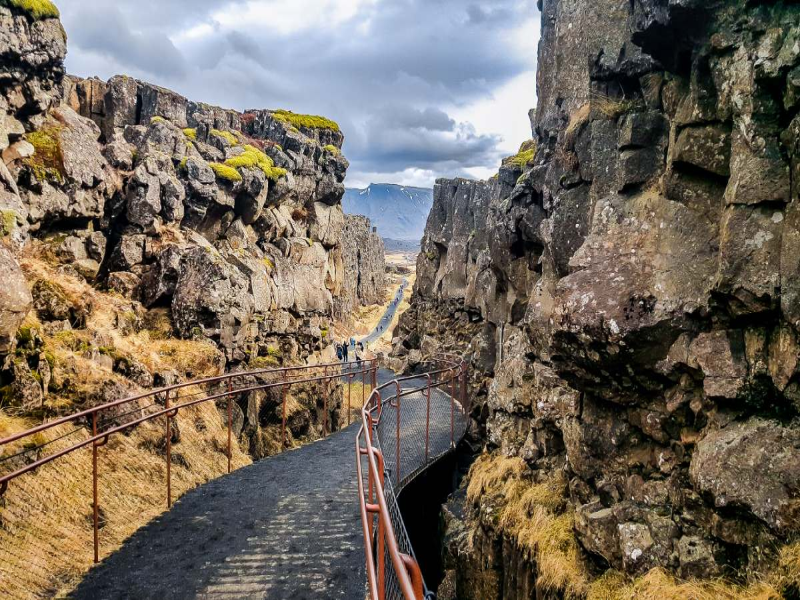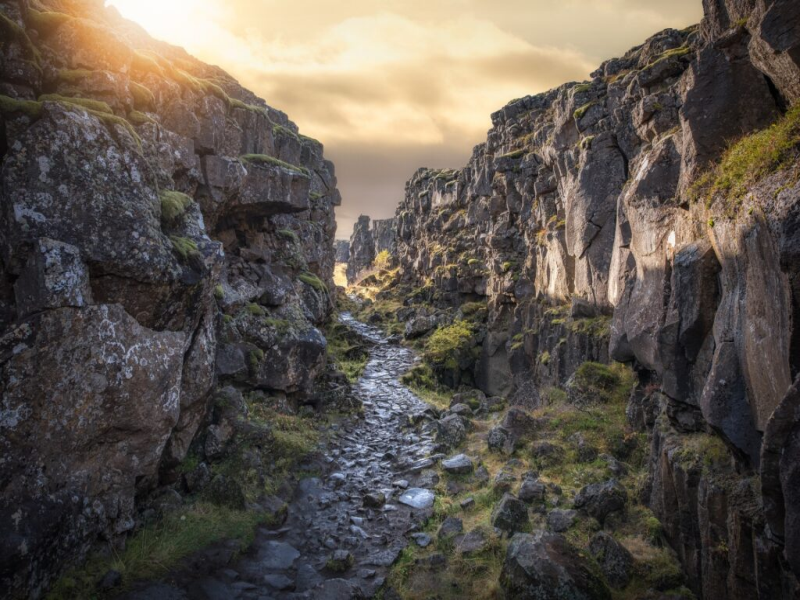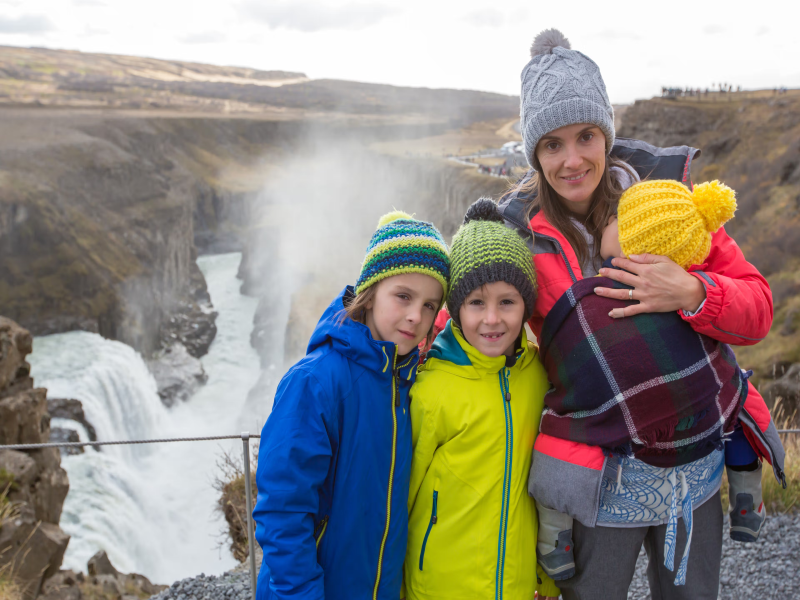Althing’s site The National Park of Thingvellir is a unique geographical region that offers a look at Iceland’s past and its magnificent geological structures that are so hard to find in any other country. Located between the main cities of the island within the region of the Golden Circle, the Thingvellir attracts the tourists from all over the world, as presenting a beautiful sight as well as important historical locality. From its geographical profile that straddles two tectonic plates to the historic location of the Icelandic parliament, Thingvellir is a historic and geographical treasure.
Thingvellir National Park may be famous for being a world heritage site, but in this article, we will also be looking at what makes this place unique in terms of both geological and historical significance. We will also consider recreational activities in the park, tips for when you are there, and why this is the only UNESCO World Heritage site on the itinerary in Iceland.

The Geological Wonders of Thingvellir National Park
What Makes Thingvellir National Park Geologically Unique?
Thingvellir National Park is truly a paradise to anyone interested in geology. Of overlaying importance is its position where the North American and the Eurasian tectonic plates converge. Continental drift, with these two enormous tectonic plates dragging themselves apart, has shaped the spectacular scenery so admired today. Thingvellir is actually geologically significant because guests can clearly view the phenomenon of tectonic plates in motion.
The rift valley at Thingvellir is an area where the Earth’s crust is being stretched and cracked. The land is slowly separating by around 2 cm (0.8 inches) each year, with the movement of the tectonic plates causing volcanic activity, earthquakes, and the formation of numerous geological features. This rift valley is not only a site of scientific interest but also a testament to the dynamic forces shaping the Earth beneath our feet.
Key geological features of Thingvellir National Park include:
- Rift valley – A deep depression formed by the diverging tectonic plates.
- The Silfra Fissure – A crystal-clear underwater crack between the plates, famous for diving and snorkeling.
- Almannagjá Fault – A visible fault line that marks the boundary between the two tectonic plates.
Understanding the geological forces at work in Thingvellir helps visitors appreciate the raw power and beauty of the landscape. The park provides a tangible demonstration of how Earth’s continents are shifting over time, constantly shaping the land we see today.
Exploring the Rift Valley at Thingvellir
The rift valley at Thingvellir is one of the park’s most fascinating features. It stretches over several kilometers and offers visitors the opportunity to walk between the tectonic plates in a truly unique setting. This valley is the result of millions of years of tectonic movements, with the North American and Eurasian plates constantly pulling apart at a rate of about 2 cm per year.
The rift valley at Thingvellir is not just a place of geological interest; it also offers stunning natural beauty. Visitors can hike through the valley, exploring the rugged terrain, crystal-clear streams, and vast open spaces. The Almannagjá fault, one of the most prominent geological features in the park, is a dramatic crack in the Earth’s surface. Standing at the edge of Almannagjá gives visitors a clear view of the land split in two by the forces of nature.
Things to know about the rift valley:
- The valley is easily accessible for visitors, with several marked trails for hiking.
- It’s a great spot for photography, especially in the early morning or late evening light.
- The area is rich in history, as it was here that Iceland’s first parliament was established in the 10th century.
Thingvellir’s Rock Formations and Faults
As you explore Thingvellir National Park, the rock formations and fault lines are among the most striking features of the landscape. One of the most famous of these is the Almannagjá Fault, a massive crack in the Earth’s surface that marks the boundary between the two tectonic plates. This fault is a geological wonder, as it’s one of the most visible places on Earth where tectonic plates meet.
Another iconic geological feature in Thingvellir is the Silfra Fissure, an underwater rift between the North American and Eurasian plates. The water in Silfra is some of the clearest in the world, offering divers and snorkelers an unparalleled experience as they float between two continents. The Silfra Fissure has become a popular destination for adventurous travelers seeking a once-in-a-lifetime underwater experience.
Facts about Thingvellir’s geological features:
- The Silfra Fissure is a must-see for snorkelers and divers. The water clarity is so high that visibility can reach up to 100 meters (328 feet).
- Almannagjá Fault is a key feature for hiking and photography enthusiasts.
- The rift valley and fissures have been the site of significant research and are considered some of the best places in the world to study plate tectonics.
Thingvellir National Park and Icelandic History
The Historical Significance of Thingvellir National Park
Thingvellir is not only a geological structure of immense value, it also holds immense value historically for Iceland. Among other attractions, the park has been listed as a location of the oldest parliament in the world – Althing. The Althing was established in the year 930 AD as an external discussion forum that provided only chieftains and local leaders to make laws and regulate conflicts at Thingvellir on an annual basis. This is the democratic system that acted as the base for Icelandic political system and shaped the structure of modern political system in Iceland.
Iceland’s Althing represents one of the earliest examples of a representative democracy in the world, long before many other nations established their own forms of government. For over 800 years, the Althing was held at Thingvellir, making it not only a political hub but also a symbol of Icelandic unity and sovereignty.
Key historical facts about Thingvellir:
- The Althing was founded in 930 AD, making it the oldest continuous parliamentary institution in the world.
- It was originally an open-air assembly where laws were made, disputes were settled, and matters of the state were discussed.
- In 1845, the Althing was moved to Reykjavik, but the legacy of the park as the birthplace of Icelandic democracy remains strong.
- The park also holds deep cultural significance, as it is linked to numerous historical events, including the adoption of Christianity by the Icelandic people in the year 1000.
Hence Thingvellir still remains an emblem of the Icelandic nationality, many people of the country reverting the place as the one of their historical significance. Cultural tourism is the process through which modern tourists get to see the places where the Vikings first settled in Iceland and many key decisions in the Icelandic saga were made as tourists get to visit Thingvellir.
Thingvellir continues to be a national symbol of Icelandic identity, with many Icelanders considering it a place of deep cultural importance. Visiting Thingvellir allows modern-day travelers to walk in the footsteps of Viking settlers and to see firsthand where crucial decisions in Icelandic history were made.
Viking History and Thingvellir
Thingvellir’s historical roots are also deeply connected to the Viking era. When the Vikings first settled in Iceland during the 9th and 10th centuries, Thingvellir became a central meeting place for their leaders. The establishment of the Althing at Thingvellir was not just a political move—it was a reflection of the social and cultural needs of the early settlers. These Viking settlers were establishing their own laws and governance structures, which would later evolve into the Icelandic legal system.
Though much of the physical evidence of Viking activity in Thingvellir is now buried, there are still relics and traces of their presence. Archaeological findings in and around the park have revealed traces of early Viking structures, artifacts, and burial sites. This adds to the mystique of Thingvellir, as it serves as a historical crossroads between the Viking past and the birth of Iceland’s modern democracy.
Viking-related facts at Thingvellir:
- Thingvellir was chosen as the site for the Althing because of its central location and the natural setting of the rift valley, which provided a dramatic backdrop for assemblies.
- The park is home to several Viking-era archaeological sites, although much of the early Viking settlement in Iceland remains undiscovered or protected.
- The Þingvellir Church, built in 1859, is a reflection of the park’s ongoing historical significance, though it’s much later than the Viking period.
Thingvellir’s connection to the Viking era and the establishment of the Althing further enhances its importance, making it a place where both Iceland’s past and its future were shaped.
Thingvellir as a Symbol of Iceland’s National Identity
Over the centuries, Thingvellir has remained a symbol of Iceland’s national pride. The site not only holds historical importance but also continues to serve as a gathering point for Icelandic people. For many Icelanders, the park represents the nation’s fight for independence from Denmark in the early 20th century. In 1944, Iceland declared independence from Denmark, and many Icelanders saw this act as the fulfillment of a long-held dream that originated with the first gatherings at the Althing in the 10th century.
Thingvellir is often visited by Icelanders on national holidays, such as Independence Day on June 17, and Þjóðhátíðardagur (National Day), to celebrate their nation’s rich history and democratic traditions. For visitors, the park offers a tangible connection to Iceland’s past, providing a place where they can reflect on the struggles and triumphs that helped shape the modern nation.
Cultural significance of Thingvellir:
- Thingvellir’s role in Iceland’s independence movement: Icelanders saw their connection to the site as integral to their struggle for sovereignty.
- The park symbolizes national unity, democracy, and the continued importance of the Althing to Icelandic identity.
- Thingvellir’s status as a cultural heritage site is celebrated each year on National Day, with ceremonies and events held at the park.
Exploring Thingvellir is really like stepping directly into the heart of the country. This is not only a geographical concern but more so historical and political one for the identity of the Icelandic nation and anyone who has been able to visit the park will attest to the fact that it is more than physical structure, it is culture Mao.
Visiting Thingvellir National Park: Tips and Information for Tourists
Thingvellir National Park is a popular site in Iceland, so many global tourists pull over here to explore the stunning geological site and remarkable history, as well as its convenience for tourists. For those seeking thrill, Thingvellir is the place to go, for history buffs, the area’s democratic history will make for an interesting read. Here is important information and several tips to help make the most of your visit to the location.
Ways of Accessing Thingvellir National Park
It is easy to access Thingvellir and this site is actually within the places to visit along the golden loop one of the rings that visitors take around Iceland. As a result the sites commonly visited involve the Gullfoss Waterfall and the Geysir geothermal area that can all be easily visited from Reykjavik in the same day.
Directions from Reykjavik:
- By car: The geographical location of Thingvellir is approximately 47 km or 29 miles, or a forty-five minutes car drive from Reykjavik. The major attractions are easy to find along with the route because the road is paved and there are signs posted indicating where to go, regardless of the season.
- By bus: For the independent travelers who do not have their own car, there are number of bus services which operates from Reykjavik to Thingvellir and usually it is included in Golden Circle services. Another possibility is taking a public bus to the park but they can contain transfers needed to get there.
- By guided tour: A large number of travelers choose the guided tours that include the Golden Circle. These tours tend to be descriptive and are particularly ideal for visitors who would not like to drive themselves.
Tip: Another advantage of a car rental is that you can go to Thingvellir on your own, without adjusting to the group’s speed, but there may be problems with roads in winter, so always check the weather in Iceland.
Entry Fees and Opening Hours
One of the best things about visiting Thingvellir is that the park itself is free to enter. While there are no entry fees for accessing the park, there is a small parking fee to use the designated parking areas. The parking fee helps support the park’s maintenance and conservation efforts. Visitors can pay for parking through a payment kiosk or via an online payment system.
Opening Hours:
- The park is open year-round, but visitor centers have specific hours depending on the season. The chief information center and the facilities are available at the main Mari pass throughout the entire year as the winter operational timetable ranges from 9 am to 5 pm while the summertime increases to 8 am to 8 pm.
- Thingvellir Church: The church that is situated in the park is actually a small chapel with its own schedule that includes visitors from 9 in the morning up to 6 in the evening.
When to go to Thingvellir National Park
”The best time to visit Thingvellir is the time when you want to feel this specific type of atmosphere,” said Mr. Gudmundsson. Although the park is available all year long, every season presents a unique way to appreciate the accomplishment and mood of the park.
Summer (June to August):
- Pros: Bigger and more light to go for hiking or carry other activities, and more sunshine.
- Cons: July and August because it can be very busy depending on the day and time of day.
- Things to do: Hiking, taking photo and capturing the scenic view, scuba diving in Silfra Fissure and visiting historical places.
Winter (November to March):
- Pros: Less influx of visitor traffic, stunning snowy scenery which brings a certain charm to the park and if one is lucky, one sees the Aurora Borealis.
- Cons: While the snow is rarely heavy enough to require ski equipment, trails can be icy, it is cold, and it gets darker earlier in the day.
- Things to do: Winter photographs, the experience of the Northern lights, and generally, any kind of slow and calm exploration of the park.
Spring and Autumn (April to May, September to October):
- Pros: Less those seen in the summer, with more manageable temperatures than both the hot summer and the freezing winter and relatively stunning watching the colors of Autumn foliage or the flowers of spring.
- Cons: Some of the trails may be muddy or wet most of the time say during the rainy season.
- Things to do: No people in the summers again – hiking, photo opportunities, and geological site seeing.
Nearby Attractions to Explore Alongside Thingvellir
Thingvellir is part of Iceland’s Golden Circle, and if you’re visiting the park, you might want to explore other nearby attractions to make the most of your trip. The Golden Circle is a 300-kilometer loop that connects three major sites: Thingvellir, Geysir, and Gullfoss.
Gullfoss Waterfall
- Located about 10 kilometers (6 miles) from Thingvellir, Gullfoss is one of Iceland’s most famous waterfalls. The dramatic two-tiered waterfall drops 32 meters (105 feet) into a rugged canyon, making it a must-see for visitors traveling the Golden Circle.
Geysir Geothermal Area
- A short drive from Thingvellir is the Geysir geothermal area, where you can witness the famous Strokkur geyser erupting every 5-10 minutes. The area is also home to hot springs, fumaroles, and other geothermal wonders, making it a fascinating stop for those interested in Iceland’s volcanic landscape.
Laugarvatn Fontana
- For a relaxing end to your Golden Circle adventure, head to Laugarvatn Fontana, a geothermal spa located near the village of Laugarvatn. This spa has open-air baths with clearly seen mountain and lake scenery which is best for the body after a day’s tour.
Things to Do while at Thingvellir: Useful Information
- Wear appropriate clothing: However, the climate in Iceland may change suddenly, even in the months of summer. In terms of dressing, you should be dressed in layers, wear waterproof jackets and shoes because if you are going to be trekking, you need to put on some good shoes.
- Stay safe: Despite the fact that all the paths around Thingvellir region can be described as easily accessible, it is still possible to come across some slippery and rough territories. Stick to the signposted trails at all times and avoid getting too close to cliffs even in parts of the year with, say, frozen conditions.
- Respect the environment: Thingvellir is on the World Heritage List, so everybody should be careful and concern the preservation of the park. Don’t select plants or pests or destruct ecosystems and use bins to throw away wastes.
- Photography: Thingvellir is great to photograph, and scenery depends on the season. Do not leave behind camera to take photographs of this scenic area and geological formations and history of the areas.
It means that to visit Thingvellir National Park is more than a tour of landscape, not even beautiful, but of an historical location. It is also geologically bizarre, historically informative, and hosts anything from walkers and divers, to spelunkers and lovers. The park is fully accessible by car, there are stunning views and the park possesses rich historical traditions of Iceland.

The Legacy of Thingvellir: A UNESCO World Heritage Site
As if this is not enough, Thingvellir National Park has additional critical distinction as a cultural and natural heritage site under UN/UNESCO standards. His scenic concept of this park as the most valuable natural asset not only in Iceland but also globally has been enhance by this prestigious status. UNESCO World Heritage listing of Thingvellir provides an opportunity to preserve its natural and cultural values and make its atmosphere preserved in the films be available to generations to comprehend the meaning of deep spiritual values.
Now, it is about time we learnt why Thingvellir was bestowed this honor and how it stands distinct on the world map.
1. Outstanding Universal Value (OUV) in terms of geology:
- Thingvellir is a prime example of an active tectonic rift zone where the North American and Eurasian tectonic plates are pulling apart. The visible rift valley and the geological features formed by the movement of these plates offer a rare, tangible demonstration of the forces shaping our planet.
- The Silfra Fissure and the Almannagjá Fault are some of the most visible and accessible features that highlight this tectonic activity, offering a unique opportunity to explore plate boundaries and their effects on Earth’s surface.
2. Historical and cultural importance:
- The Althing, founded in 930 AD, is the world’s oldest surviving parliamentary institution. Thingvellir was the center of Icelandic governance for over 800 years, where laws were made, disputes settled, and Iceland’s early democratic principles were established. This makes the park an essential location for understanding the early development of democratic systems and their evolution.
- In addition to its political legacy, Thingvellir also represents Iceland’s struggle for independence, serving as a symbol of the nation’s sovereignty.
What Makes Thingvellir Famous?
Thingvellir has the potential of allowing the individuals to make observation of geological activity as well as learn about the histories of the human beings. The park is not only a scenic park but it is a historical site, where Icelanders could feel the establishment of the nascent state of democracy in their country.
Key reasons why Thingvellir stands out as a UNESCO World Heritage Site:
- The rift valley: Thingvellir is located on the eastern stretch of the Mid-Atlantic Ridge at the meeting point between the North American and Eurasian tectonic plates. The rift valley is still widening and gives a very live model of tectonic movement which is very hard to come across especially in such a beautiful and properly preserved region.
- The Althing: Thingvellir site played significant in the formation of Iceland legal structure that was the fountain of democracy in Iceland. Culturally therefore, the park is valuable for it is in Reyjavik that the political history of Iceland began.
- Cultural continuity: Thingvellir affects Iceland even today. Of course, the park is not only an object of historical ‘preservation’; the Icelanders continue to celebrate their most important national events within it, making it a vivid symbol of their unity. That is why its cultural agenda can be traced through the presence of the park in Icelandic culture from the Viking age through the present day.
How UNESCO’s Recognition Beneficial for Thingvellir
Listing Thingvellir as a UNESCO World Heritage site has brought it additional safeguard and more financial resource for conservation. UNESCO listing guarantees among other things, protection of the park’s heritage(“>updated) natural and historical aspects so as to cater for the tourism and conservation interests, responsible visitation of the site.
How UNESCO status helps protect Thingvellir:
- Legal protections: UNESCO World Heritage Sites are immune to exploratory and destructive activities all across the globe thus rendering Thingvellir favorable geological and historical formations safe form vices.
- Conservation efforts: Besides, due to UNESCO support, Iceland has been able to introduce some essential actions to protect and maintain the balance on the park’s ecosystems, as well as avoiding over-crowding the area. This involves restricting the accessibility of some specific areas, preservation of park’s walking tracks and analyzing the impacts of tourism on the area.
- Awareness and education: UNESCO’s stamp also has the effect of increasing the public’s attention to Thingvellir. In turn, there are more educational projects built round the site, aiming at enhanced perception of its importance to the people living in the region as well as the tourists coming to the area.
Thingvellir’s Significance for the Entire World
It therefore becomes noteworthy to embrace Thingvellir as it becomes a world heritage site benefitting Icelanders as well as everyone in the world. The park is a constant symbol of the nonyellow strength of nature as well as the unchanging human strive for authoritative/political systems. Through safeguarding Thingvellir National Park UNESCO has created a possibility for future generations to learn from, and value the historical and geographical aspects of the area for eternity.
Things to consider about Thingvellir’s global importance:
- A place for scientific study: A great number of researchers and geologists visit Thingvellir to observe the impact of tectonic activity on geological landscapes and structures. This site presents an opportunity to learn about geology of the Earth in the most practical way.
- A symbol of democracy: The feudal structure in Thingvellir was efficient enough and however the place remained as the symbol of freedom and democratic front that inspires the democratic movements all across the world even this date. It is a place where systems of law and governance were set up and brings out the argument of democracy therefore a point of reference.

Conclusion
Thingvellir National Park being on the list of UNESCO World Heritage Site enhances its position of a unique valued global destination. Nonetheless, Thingvellir is also valuable for its geology, its history, and for the exceptional role it plays for illustrating how the forces of nature and history part and interact. When translated as the ‘assembly place’, Thingvellir continues to be one of the true natural and historical wonders to be found anywhere in Iceland, let alone the world: declared as the cradle of democracy and as one of the placement points for the tectonic plates.
From the viewpoint of the rift valley to the historical site of the first parliament of Iceland – Thingvellir is the unique opportunity, standing at the intersection of historical exploration and geological fascination. It is a message about the strength of the now as well as of human abilities in creating the communities which are to endure.
References
- UNESCO World Heritage Centre – “Thingvellir National Park.”
Retrieved from: https://whc.unesco.org/en/list/1150/
This official page provides detailed information about Thingvellir’s designation as a UNESCO World Heritage Site, outlining its geological and historical significance. - Icelandic Tourist Board – “Thingvellir National Park.”
Retrieved from: https://www.visiticeland.com/article/thingvellir-national-park
A comprehensive guide to Thingvellir, offering information on the park’s natural features, historical landmarks, and practical tips for visitors. - Guide to Iceland – “Thingvellir National Park: A Geological and Historical Overview.”
Retrieved from: https://guidetoiceland.is/travel-iceland/drive/thingvellir-national-park
A resource on the geological and historical importance of Thingvellir, highlighting the park’s key features and what visitors can explore. - Iceland Geology Association – “The Geology of Iceland: Thingvellir National Park.”
Retrieved from: https://www.jardvis.is/en/geology-of-iceland
Provides insights into the geological features of Thingvellir National Park, including information on the tectonic plates and their impact on the landscape. - Iceland Travel Blog – “The Althing and Thingvellir: Iceland’s Historic Site of Governance.”
Retrieved from: https://www.icelandtravel.is/blog/thingvellir-history/
An informative post detailing the history of the Althing and its connection to Thingvellir, emphasizing its role in the development of Icelandic governance and democracy.




